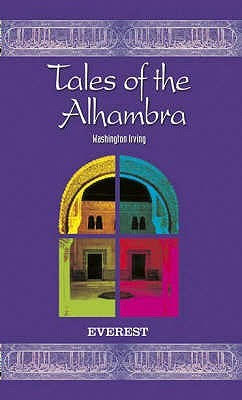"Tales of the Alhambra" by Washington Irving

Above: "Tales of the Alhambra" - Washington Irving, 610 pages.
I now feel that a visit to The Alhambra cannot be fully appreciated without a read of Irving's book.
I completed reading this book today.
On my first visit to the Alhambra Palace in Granada, Spain in September of 2018, I bought a copy of "Tales of the Alhambra" to read on my return.
As I read the book, after the fact, I remembered many of the locations, towers, and courts referred to in the narrative. I now feel that a visit to The Alhambra cannot be fully appreciated without a read of Irving's book.
In the spring of 1829, Washington Irving, America's first great writer, with an unnamed, low ranking Russian diplomat, a new friend, began an expedition on horseback, from Seville to Granada. On arrival in Granada, Irving asked the then governor of the historic Alhambra palace, as well as the archbishop of Granada, for access to the palace, which was granted because of Irving's celebrity status.
The book combines the palace's description, myths associated with the palace's past and narrations of real historical palace events.
After staying at Alhambra palace for several months, Irving continued to travel through Spain until he was appointed as secretary of legation at the US Embassy in London, and later, US Ambassador to Spain.
While staying at The Alhambra Palace, Irving meets an old man, Mateo Jimenez, "a son of the Alhambra", who had lived at The Alhambra all his life. Jimenez told Irving stories of buried, lost treasure underneath the buildings, secret chambers, the three princesses imprisoned by their father, the King, in a lonely tower, and countless other legends and myths.
The old man shows Irving the palace's reddish towers, pools full of fish balconies where the Sultana looked down at her subjects, elegant gardens, right out of an Arabian Nights fable, the huge Ambassadors Hall, where receptions were held, the Court of the Lions, the Royal Baths, and numerous other attractions.
At the time (1829), The Alhambra was falling into ruin. The structure was crumbling, neglected and underappreciated.... a foreign structure.
Via his writings, capturing in elegant, elegiac prose, the stories of old Jimenez, Irving brought the structure back to life. The Alhambra was restored in later centuries and became one of the most visited palaces in the world.
Some examples of Alhambra stories as told by Jimenez to Irving:
A mason is awakened in the middle of the night by a ghost from the past and then led blindfolded to a secret court with a fountain, where he is paid to bury a treasure.
An astrologer learns the secrets of the book of the dead inside an Egyptian pyramid and later perfomrms miracles for a king of Granada.
A Celtic enchantress puts the same wizard to sleep with her harp music.
Prince Ahmed Al Kamel, The Pilgrim of Love, learns the language of birds and goes on a quest for his lovely Christian virgin, in the company of a wise owl and a socialite parrot.
A poor laborer is rewarded for his kindness to a stranger with the key to another buried treasure, and later uses his wits to outsmart a greedy governor.
Ands so on...
On my arrival last summer in Granada, I had little knowledge of the Moorish period in Spain which lasted almost 800 years. The last Moors were forced out of Spain in 1492 by King Ferdinand and Queen Isabella.
The time frames stretch my ability to comprehend. Irving made his visit to the Alhambra and wrote his book almost 200 years ago. And, he was writing about an eight hundred year period of Spanish history that ended almost three hundred fifty years before he arrived.
Who were the Moors, who built the lavish Alhambra Palace?
In 711 about 15K troops formed by Moors crossed the Mediterranean sea from modern day Tunisia to the Iberian peninsula of Europe, and accomplished the conquest of Spain.
The Iberian peninsula then came to be known in Arabic as Al-Andalus, which at its peak included most of modern day Spain and Portugal.
Differences in religion and culture led to a centuries-long conflict with the Christian kingdoms of Europe, which tried to reclaim control of the Muslim areas. This conflict was called the "Reconquista." The fall of Granada in 1492 marked the end of Muslim rule in Iberia, although a Muslim minority persisted until their expulsion in 1609.
During the period of Moorish rule in Spain, a period when Christian Europe was languishing in the Dark Ages, arts, literature, architecture, astronomy, mathematics all flourished.
The Moors were tolerant of Christians and Jews under their dominion. Christians and Jews were allowed to live in peace, though they were compelled to pay a disproportionate tax.
The relative tolerance practiced by Moorish rulers was not reciprocated by the Christian victors of the Reconquista in 1492. The Christians initiated the Spanish Inquisition to force convert Jews to Christianity. The Christians never fully trusted the loyalty of the Jewish converts and eventually, by 1500, had expelled the Jews altogether.... and the Muslims also in 1609.
1492, of course, is an important year for Western Civilization. It was the year of Christopher Columbus' discovery of the new world. It is commonly known that Columbus' voyage to "the Indies" was financed by Spanish queen, Isabella. It is less well known that Columbus and Isabella, within hearing distance of the "Moor's last sigh," struck their auspicious financial deal in one of the rooms of The Alhambra Palace.
"Tale's of the Alhambra" is a great book. The prose is lyrical, elegiac, and archaic... but, it is readable and beautiful. Modern day prose seems functional and pragmatic in comparison. It is eye opening, though, to read two hundred year old prose, and see how its mellifluous flow, and oft archaic usage, enhances the imagery of times gone by.